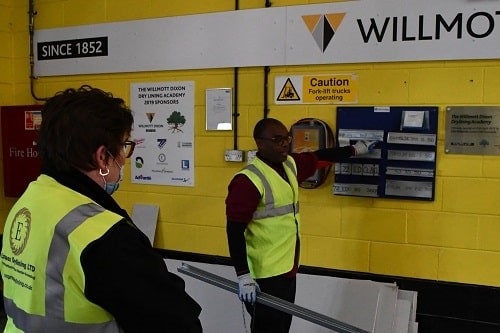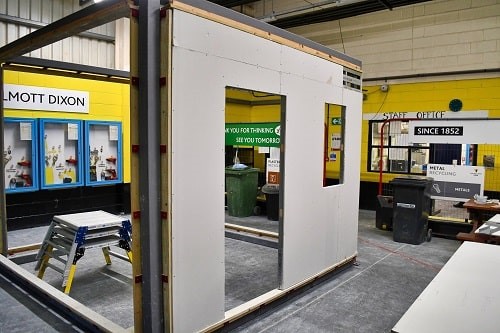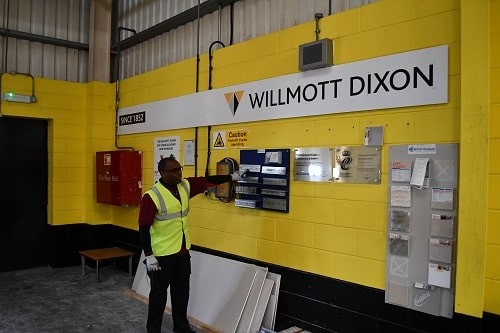“You can see they want that thread of hope. You’re somebody who’s going to believe in them and they come away with the faith that you’re going to actually do what it says [on the tin].”
Features
Giving prisoners a lifeline
When British Safety Council member, Alistair Donaghey, Regional Head of Safety, Health and Environment (SHE) at Willmott Dixon, spoke to the Construction Sector Interest Group about its training academy at HM Prison Elmley, we had to find out more about it. So we went down there to see first-hand how the work is transforming lives.
Elmley is a prison for men on the Isle of Sheppey in Kent. Denominated a Cat B/C prison it’s easy to assume that the 1,100 prisoners here are all in for petty crimes. But that’s the first assumption to challenge when it comes to our visit. The category refers to the likelihood prisoners will try to escape and to the risk of their committing another similar crime, not the severity of the crime itself. So here at Elmley, there are prisoners serving time for crimes ranging from theft to armed robbery and murder.
 Julie and John help to run the dry lining academy. Photograph: HM Prison Elmley
Julie and John help to run the dry lining academy. Photograph: HM Prison Elmley
Education has been a focus in prisons since the early 1900s when a change occurred in attitudes to crime. Whereas prisons had been a place of hard labour and punishment, there was a growing acceptance that people turned to crime because of their circumstances, such as poverty or upbringing. This meant that prisoners started to receive better treatment – including access to training and education – with the goal that they reformed and would be less likely to reoffend on release.
A big task
But, today, there are challenges in engaging such a large cohort of men at Elmley prison. 90 per cent of men arrive with addiction issues to drugs or alcohol and violence is not uncommon.
Joe Rook MBE, head of reducing reoffending at the prison, describes the size of their task: “We have everyone here from refuse collection to company boss. We try [with education] to make everything as individual as we can. There are prisoners here who’ve run multi-nationals and they have absolutely no common sense – people have always done things for them.
"On the other hand, if you’ve run a gang in Brixton you may be very self-sufficient but that’s all you know. So we have to tailor [the training] to the individual. Some people can’t speak English at all, so we cater for them, as well as the person wanting to continue Open University. We try and expand the project to what the community needs.”
 Dry lining is a system for cladding the internal faces of buildings, such as walls and ceilings, and is a very useful skill in the construction industry. Photograph: HM Prison Elmley
Dry lining is a system for cladding the internal faces of buildings, such as walls and ceilings, and is a very useful skill in the construction industry. Photograph: HM Prison Elmley
It sounds a challenging brief. Not only that, but Elmley has a high turnover – up to 400 men are coming and going each month. Some, on remand waiting to be sentenced by local courts, others being transferred from other prisons as they are decategorised.
The average stay at Elmley is three to nine months. Mandy Huggins, head of education, has the task of planning all the courses prisoners attend and ensuring they are at capacity: “People join and then sometimes drop out. But we have to keep courses fully subscribed to run them. It’s a real challenge.”
Real job outcomes
It’s a strong testament, then, that the Willmott Dixon dry lining academy is one of Elmley’s most successful projects. The course runs four hours per day, every day for 4–6 weeks. Prisoners who complete it to a standard get a certificate ‘rubber stamped’ by Willmott Dixon. After this, they will be able to meet prospective employers at job fairs or apply for jobs that are posted in the prison employment office.
Joe says the discipline of a rigorous timetable tied with real job outcome possibilities can be life changing for prisoners. “It starts with someone who has no hope, someone who’s perhaps never worked, who’s never done anything except sit at home on their PlayStation for 20 years,” he explains. “They don’t believe that people will employ them. This course lets them see that people will. They don’t believe they have the skill set or ability to learn, and yet this course will give them a work ethic – they get up every day, they won’t [call in] sick. Instead of choosing to go to the gym they’ll come in and do the course.”
 Joe Rook: “They [prisoners] don’t believe that people will employ them. This course lets them see that people will."
Joe Rook: “They [prisoners] don’t believe that people will employ them. This course lets them see that people will."
The dry lining academy is not just about technical accomplishment, it also teaches social skills: “Prisoners learn the behaviour of what’s required on a building site or for any other job,” says Joe, who was last year awarded an MBE (Member of the British Empire) for his work in helping to stop prisoners re-offending on release from jail. “They learn how to interact with each other. The prison environment is quite harsh and they learn that this is a work environment.”
The dry lining academy: a positive atmosphere
We head off to an outbuilding where the dry lining tuition takes place. Prisons are strange places. We pass an exercise yard, which is exactly as you would remember from films – but there the glamour ends, as prisoners are just walking round its high-walled perimeter for their daily exercise.
We pass a hall where men are meant to be assembling tea and sugar into bags – but the work is monotonous, and they peer at us with hostile curiosity. In short, it’s easy to see how hopeless it could feel to be in prison.
At the dry lining academy, there’s an immediate change. Dry lining is a system for cladding the internal faces of buildings, such as walls and ceilings. It provides acoustic and fire insulation and can also help with heat insulation. It’s skilled and hard work and prisoners are busy and focused on measuring and cutting plasterboard, sealing joints, reading drawings and drilling panels.
Speaking to the prisoners it’s clear how they value this training. A young-looking lad, Sam, says he used to be a general labourer – this training could help him get a better paid job on release.
Rick, 45 has three kids with his ex-wife, so he tells us that he wants to create more rooms for his kids at his house by putting up walls. Tom, 47, has done five of these six-week sessions, and is on life sentence. “My parole meeting is coming up and I want a job on release,” he says determinedly.
 The dry lining academy was set up by Willmott Dixon in April 2019, with a plaque marking the occasion. Photograph: HM Prison Elmley
The dry lining academy was set up by Willmott Dixon in April 2019, with a plaque marking the occasion. Photograph: HM Prison Elmley
Joe says the course has this positive atmosphere and better behaviour because it is voluntary. It provides learning on many levels, and breakthroughs can be big or small. “Some prisoners hate a classroom because they don’t think they’re capable of [English and maths], but they’ll go in there and be able to measure stuff, and that embedded maths and English is coming through in a different direction,” he says. Some prisoners have a reading age of 10. “It’s about those small steps which can be just as significant as the big leaps,” says Joe.
Risks of handling tools
But there’s no shying away from the risks of allowing prisoners to handle tools like drills and saws for cutting panels. Each prisoner has been risk assessed individually beforehand to determine how likely they could be a danger (remember – this is built into the prison A/B/C categorisation system too). “We haven’t had an incident in there – that’s not to say there couldn’t be. It’s the same as on a building site, tempers do fray everywhere – but here they don’t, they haven’t,” says Joe. “We minimise each step with a risk assessment.”
Each tool has its ‘shadow’ shape in the tool cabinet, so it shows clearly if one is missing and where prisoners must put them back after use: “They can’t leave the workspace until all the tools are accounted for which limits the risk to that one small area,” says Joe. Elmley’s head of security has helped to put this project in place safely: “He saw what we wanted to do, and went ‘how can we help you achieve that safely?’”
Reducing reoffending
Alistair Donaghey is another ‘yes we can’ person. In 2017, with his vision Willmott Dixon set up Ready for the Gate, a programme which gives CITB approved Health & Safety training and CSCS card accreditation to prisoners.
Supply chain partners supported the initiative by attending careers events and offering employment in the construction industry to those leaving prison. In its first year, in 2017 at Elmley, 39 people took part in the programme and none reoffended. It’s a small sample, but it’s a 100 per cent success rate. In comparison, a quarter (25.6 percent) of prisoners went on to reoffend in England and Wales in 2020/21 on their release.
The dry lining academy was the natural next step and opened in April 2019 (there is a plaque on the wall to mark it) making this year its fourth anniversary. Alistair recalls how it started: “We knew there was a skill shortage of dry liners and we thought, why don’t we start our own Academy?” Joe adds it has been the perfect match. “I’ve got a workforce that needs something to do. He’s got employment opportunities galore that need to be filled.”
Although education has been a focus for over a century, it’s not always been outcome focused. Alistair says he’s seen prisoners come looking for work having learned how to build brick barbecues, which is not much use on site: “I’m all for training, but a lot of the time, what prisons were doing was running courses to take prisoners out of their cells to keep them busy. But then not giving them skills they could use when they got released.”
Prisoners at the academy learn the exact skills they need because Willmott Dixon have trained two of Elmley’s staff – Julie and John – in their way of dry lining, spending six weeks on building sites with the company.
117 prisons to go
He is completely unfazed by the baggage prisoners carry in their histories, focusing instead on the potential they possess. “You get past all their bravado and that’s amazing when that happens because you can see a light go on in their heads. I always make a point of turning [their disclosure letter of crimes committed] face down and saying ‘I don’t care what you’ve done’. I say, well, what support and help do you want from me to be the best version of yourself?’ And then let them talk. That’s it.”
He is currently setting up an academy in HM Prison Lincoln and Belmarsh Prison, making light of his achievements: “I’ve only got another 117 prisons to go.” His enthusiasm is infectious and trumps any desire to take credit or glory from his altruistic initiative. “This can be replicated in every suitable prison in the UK. Anyone can take the business model and just do it.”
For more information:willmottdixon.co.uk/building-lives-outside-prison
FEATURES

Sedentary working and how to combat the ‘sitting disease’
By Gavin Bradley, Active Working on 05 April 2024
Prolonged and excessive sitting poses a major risk to our health, but the Get Britain Standing campaign and On Your Feet Britain Day on 25 April are a great way of encouraging workers to sit less and move more.

Company culture and wellbeing: a crucial link
By Bex Moorhouse, Invigorate Spaces on 05 April 2024
Investing in measures to support worker wellbeing will be ineffective unless the company culture genuinely incorporates values like teamwork, involvement, flexibility and innovation.

Office design and culture: happier and healthier staff – or the opposite?
By Guy Osmond, Osmond Ergonomics on 03 April 2024
Applying ergonomic principles to workstation set-ups and ensuring the physical environment supports neurodivergent people are just some of the ways of creating an office where everyone can thrive, but a supportive and positive organisational culture is vital too.


